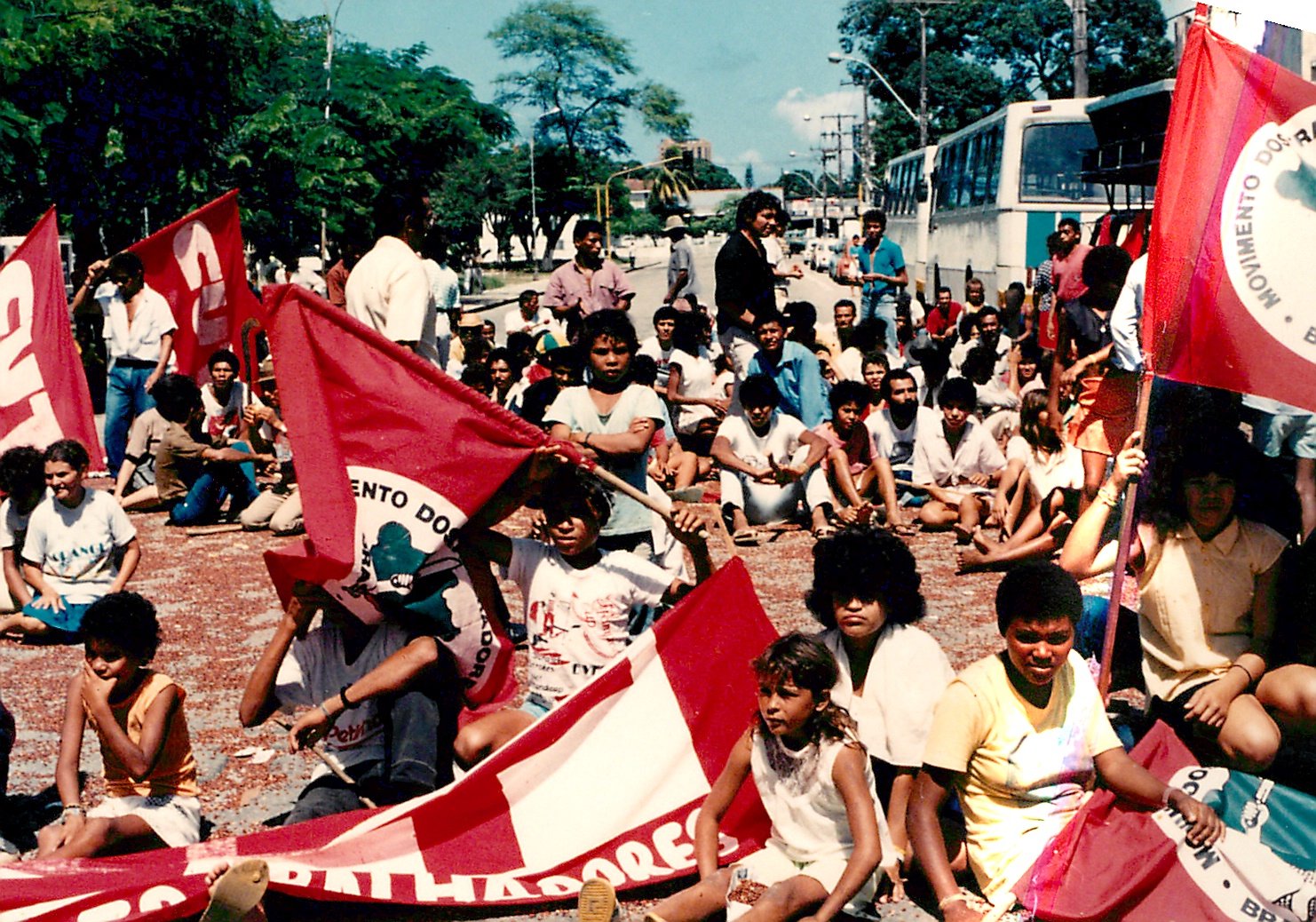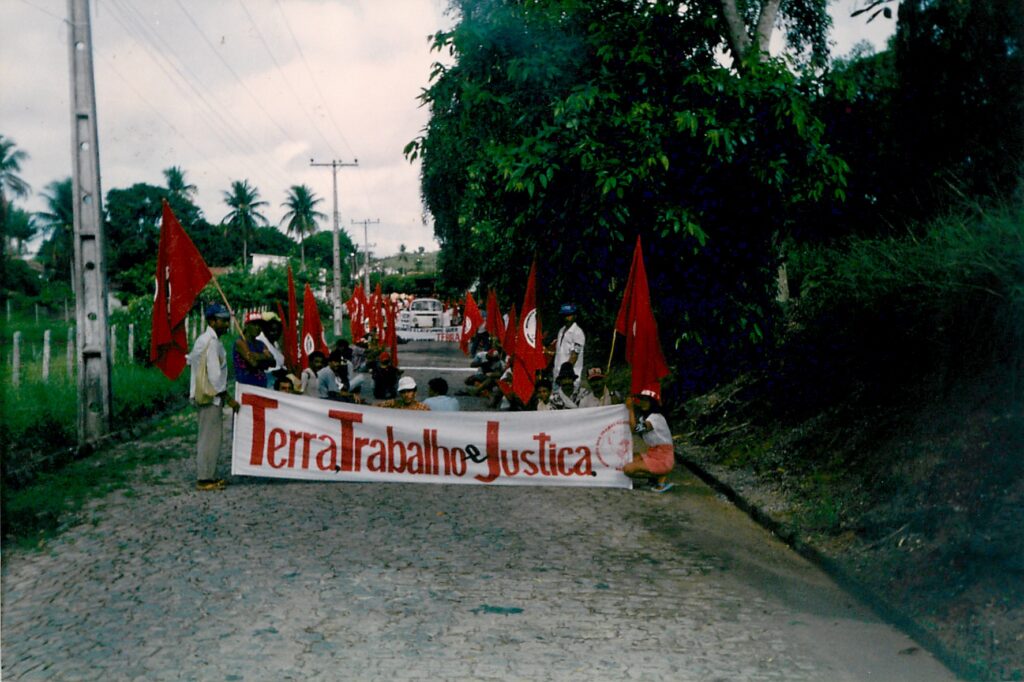MST @ 40: The Agrarian Question in Brazil

Below is an excerpt from Dossier No. 75 of the Tricontinental Institute for Social Research, which examines the MST’s tactics, organizational forms, and explains why it stands as the only peasant social movement in Brazil’s history to survive for over a decade against the political, economic, and military power of Brazil’s large landowners. For the full edition, click here.
From the sixteenth century onwards, what is now Brazil was founded and organised as an export colony based on large-scale land ownership, slave labour, and export-oriented monoculture production. Through gunpowder and the cross, the Portuguese colonial enterprise created a violent rupture with indigenous societies’ way of life, introducing a concept that was alien to them: private ownership of nature’s common goods.
In 1850, faced with the imminent end of slavery due to abolitionist movements and uprisings by enslaved peoples, the Brazilian Empire instituted the country’s first land law to prevent freed slaves from accessing the country’s greatest source of wealth: land. Through this law, land became a commodity. Furthermore, the plantation model, centred on large estates that relied on export-oriented monoculture and the super-exploitation of labour, would become the only constant in Brazilian history, regardless of whether Brazil was a Portuguese colony or an independent nation, whether it was a monarchy or a republic, and whether it was characterised by a parliamentary or a presidential system of government.
The agrarian question has been a central theme in Brazil’s history and the reason for many uprisings, revolts, and popular movements, from indigenous resistance and uprisings against slavery to the establishment of quilombo communities and the first peasant and labour movements.
The role of the state in defending the interests of landowners and repressing the poor is particularly noteworthy. While indigenous and enslaved populations were primarily persecuted and attacked by private militias, the army of the newly declared republic was used to crush the movements in Canudos (1897), a self-managed community of 25,000 peasants; Contestado (1916), an armed revolt by farmers who sought to prevent their lands from being taken over by an American railway company; and other organisations such as the Peasant Leagues, which fought for agrarian reform before the business-military coup d’état of 1964.
As a consequence of centuries of repression, twenty-first century Brazil remains the country with the second-highest level of land concentration on the planet, a title it has held throughout the last century, with 42.5% of land controlled by less than 1% of the population. Meanwhile, there are 4.5 million landless peasants.
Though the class enemies of landless rural workers are the large landowners and transnational companies that appropriate land to produce commodities, part of the pressure generated by people’s movements must also be directed towards the state. This is necessary, in part, because of the nature of the Brazilian Constitution, which was approved in 1988 after the fall of the dictatorship and has many progressive components – including some related to agrarian reform – since it was drafted amidst the rise of mass popular struggles. For instance, Article 184 requires rural property to fulfill a social function, be productive, and respect labour and environmental rights. The state has the right to expropriate landholdings that do not meet these criteria, though it must compensate the owner before transferring the deed to public ownership or granting land rights to the landless families who settle there.
Nonetheless, over the last few decades, large, landed estates have shifted to a model known as agribusiness, leading Brazil to become the largest consumer of pesticides in the world, with a record consumption of 130,000 tonnes in 2023. International financial capital, which now controls the entire rural production chain, from seeds to the sale of agro-industrial products, has made substantial investments in large, unproductive estates that are used for speculation.
In 2016, twenty foreign corporations controlled 2.7 million hectares of Brazilian agricultural land.
This land is used for export-oriented monoculture, now converted into commodities (primary products traded on a large scale according to global standards) as financial and speculative assets and traded on stock and commodities exchanges. In 2021, a mere five commodities – soy, corn, cotton, sugar cane, and cattle – accounted for 86% of Brazil’s agricultural land as well as 94% of the volume of production and 86% of its value.
This economic power is also manifest in political power, as evidenced by the fact that people who represent agribusiness interests have held ministerial positions in every single administration over the last three decades. The Ruralista Caucus, a multipartisan organisation of elected representatives dedicated to defending the interests of agribusiness, brings together 324 members, or 61%, of Congress and 50 members, or 35%, of the Senate. This has given the group enough power to pass environmental and land deregulation laws and to submit the MST to four investigations through the Parliamentary Commission of Inquiry (CPI) over the last two decades. No other grassroots organisation in Brazil’s history has been the object of so many attempts at criminalisation by parliament.
The first CPI took place in 2003 and sought to force then President Lula’s administration to distance itself from the MST as well as to prevent public funds from being allocated to agrarian reform and to criminalise the struggle for land. The 2023 CPI investigation, led by members of the most radical core of former President Jair Bolsonaro’s coalition, had similar goals to pressure the new Lula administration, which brought the Workers’ Party back to power following a judicial coup and the 580-day imprisonment of then-candidate Lula. However, it backfired. By the time the 2023 investigation took place, the MST’s public image had been strengthened as a result of the solidarity activities it carried out during the COVID-19 pandemic. This in turn increased solidarity with the MST and thereby deprived the commission of political or media support, leaving it unable to even approve a final report.
This is no small feat, given the hegemony of agribusiness in Brazilian society, which is built upon not only a sophisticated and powerful cultural industry, from television to music, but also archaic methods of violence and repression. This is evidenced by the CPT’s 2022 survey, which recorded 2,018 incidents of social conflicts in the countryside – a 33.6% rise from the average figure in 2016 – and 47 murders linked to land or environmental issues.
But, despite its deep entrenchment in Brazilian, society, economics, and politics, agribusiness is not the only agricultural model, nor is it one that responds to the needs of the majority or the planet. During its Third National Congress in 1995, the MST presented and ratified its agrarian reform programme for the first time, based on an analysis of the class struggle in the Brazilian countryside and a set of proposals to transform the structure of Brazilian land ownership and the conditions of rural life.

In 2015, the programme was updated with an important theoretical and structural change: while political parties and universities misunderstood the nature of and even welcomed agribusiness in Brazil, the MST built a collective definition of the term as ‘the presence of transnational financial capital in the countryside for the production of commodities’. Furthermore, the MST warned that the mere existence of agribusiness and its links with the state prevented any classical type of agrarian reform within a capitalist framework, in which land is simply redistributed or its access is democratised, from moving forward.
In this context, the MST redefined its tactics and its agrarian programme by creating a new concept: popular agrarian reform. In addition to demanding that land be distributed to peasants, popular agrarian reform discusses the need to produce healthy food for the entire population alongside changing the current production process, which is based on the agribusiness model, to one based on agroecology, which preserves nature’s common goods. This shift also helped build a greater alliance with urban workers, who are the biggest beneficiaries of access to affordable, healthy food. Popular agrarian reform not only seeks to further the interests of the peasantry, but those of society as a whole. This is reflected, for instance, in its understanding of food sovereignty, in its potential to generate alternative forms of employment and income, and its commitment to fighting the environmental catastrophe.
Cover Image: Rural Workers’ Day (Alagoas, 25 July 1991) Credit: MST Archive
